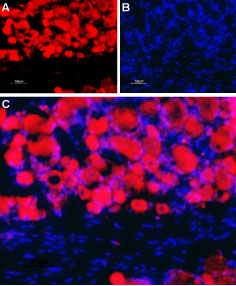Overview
- Peptide CYEGVNILRIPAKR, corresponding to amino acid residues 95-108 of rat nAChRβ4 (Accession P12392). Extracellular, N-terminus.

 Western blot analysis of SH-SY5Y human neuroblastoma cell lysate (lanes 1 and 4), rat dorsal root ganglion (lanes 2 and 5) and mouse brain (lanes 3 and 6) lysates:1-3. Anti-Nicotinic Acetylcholine Receptor β4 (CHRNB4) (extracellular) Antibody (#ANC-014), (1:200).
Western blot analysis of SH-SY5Y human neuroblastoma cell lysate (lanes 1 and 4), rat dorsal root ganglion (lanes 2 and 5) and mouse brain (lanes 3 and 6) lysates:1-3. Anti-Nicotinic Acetylcholine Receptor β4 (CHRNB4) (extracellular) Antibody (#ANC-014), (1:200).
4-6. Anti-Nicotinic Acetylcholine Receptor β4 (CHRNB4) (extracellular) Antibody, preincubated with Nicotinic Acetylcholine Receptor β4/CHRNB4 (extracellular) Blocking Peptide (#BLP-NC014).
 Expression of nAChR β4 in rat dorsal root ganglionImmunohistochemical staining of rat dorsal root ganglion (DRG) frozen sections using Anti-Nicotinic Acetylcholine Receptor β4 (CHRNB4) (extracellular) Antibody (#ANC-014). A. nAChRβ4 labeling (red) appears in neuronal cell bodies. B. Nuclear staining using DAPI as counterstain (blue). C. Merged images of A and B.
Expression of nAChR β4 in rat dorsal root ganglionImmunohistochemical staining of rat dorsal root ganglion (DRG) frozen sections using Anti-Nicotinic Acetylcholine Receptor β4 (CHRNB4) (extracellular) Antibody (#ANC-014). A. nAChRβ4 labeling (red) appears in neuronal cell bodies. B. Nuclear staining using DAPI as counterstain (blue). C. Merged images of A and B.
 Expression of nAChR β4 in rat PC12 cellsCell surface detection of nAChR β4 in live intact rat pheochromocytoma PC12 cells. A. Cells were stained with Anti-Nicotinic Acetylcholine Receptor β4 (CHRNB4) (extracellular) Antibody (#ANC-014), (1:100), followed by goat anti-rabbit-AlexaFluor-594 secondary antibody (red). B. Cell nuclei were visualized using Hoechst 33342 (blue). C. Merge of the two images.
Expression of nAChR β4 in rat PC12 cellsCell surface detection of nAChR β4 in live intact rat pheochromocytoma PC12 cells. A. Cells were stained with Anti-Nicotinic Acetylcholine Receptor β4 (CHRNB4) (extracellular) Antibody (#ANC-014), (1:100), followed by goat anti-rabbit-AlexaFluor-594 secondary antibody (red). B. Cell nuclei were visualized using Hoechst 33342 (blue). C. Merge of the two images.
- Albuquerque, E.X. et al. (2009) Physiol. Rev. 89, 73.
- Karlin, A. et al. (1986) Ann. NY. Acad. Sci. 463, 53.
- Kalamida, D. et al. (2007) FEBS J. 274, 3799.
Acetylcholine, released by cholinergic neurons, activates two groups of acetylcholine receptors (AChRs); muscarinic AChRs (mAChRs), which belong to the G-protein coupled receptor (GPCR) superfamily, and nicotinic AChRs (nAChRs), which belong to the ligand-gated ion channel superfamily. nAChRs also respond to nicotine, hence their name1.
To date, 17 different but related subunits of nAChRs have been identified and cloned. They consist of α subunits (α1-10), which are responsible for the binding of ligands. In fact, this subunit includes a Cys-loop in the first extracellular domain that is required for agonist binding2. The other subunits responsible for making up the active receptor are the β (β1-4), γ, δ and ε subunits3. Structurally, all subunits have the following: a conserved large extracellular N-terminal domain, three conserved transmembrane domains, a variable cytoplasmic loop and a fourth transmembrane domain with a short extracellular C-terminal domain. An active nAChR is generally a heteropentamer of these various subunits organized around a central pore1.
While most β subunits are neuronal, the β1 subunit forms functional receptors along with other subunits in the muscle3. In neurons the α2-α6 and β2-β4 subunits form heteropentameric receptors, usually with a (αx)2(βy)3 stoichiometry3.
Application key:
Species reactivity key:
Anti-Nicotinic Acetylcholine Receptor β4 (CHRNB4) (extracellular) Antibody (#ANC-014) is a highly specific antibody directed against an epitope of the rat protein. The antibody can be used in western blot, immunohistochemistry, live cell imaging, and immunocytochemistry applications. It has been designed to recognize nAChRβ4 from mouse, rat, and human samples.
